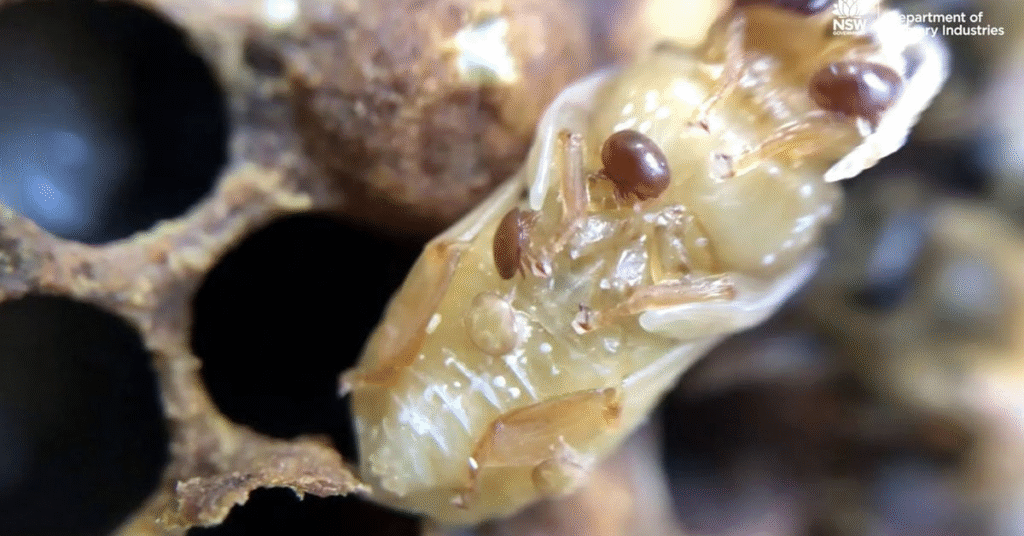Varroa mite infestation is one of the most serious threats to honey bee colonies, especially during the critical sting season—late winter through early spring. At this time, colonies are vulnerable as they transition from winter survival to spring build-up. But how does hive insulation affect the survival and reproduction of Varroa destructor?
This article explores how insulated hives impact Varroa mite biology, what this means for colony health, and how beekeepers can balance insulation with effective mite management.



What Is Hive Insulation?
Hive insulation refers to methods used by beekeepers to moderate internal hive temperature and humidity during extreme seasonal conditions. During the sting season, insulation:
- Maintains internal warmth
- Reduces heat loss
- Prevents condensation
- Promotes early brood development
Materials commonly used include foam boards, insulated wraps, quilt boxes, and double-walled hive bodies
Hive Insulation and Varroa Mite Reproduction
How Varroa Mites Reproduce
Varroa mites reproduce inside capped brood cells, especially drone brood, which offers longer development time. Warmer hive interiors—common in insulated hives—can lead to:
- Extended brood-rearing seasons
- More brood cycles for mites to infest
- Faster Varroa population growth
While insulation benefits the colony by reducing energy expenditure, it also inadvertently benefits Varroa mites if left unchecked
Temperature, Humidity, and Mite Survival
Varroa mites are sensitive to microclimatic conditions. Research published in the Journal of Insect Science found that mites thrive under conditions of:
- Stable warmth (~32–36°C)
- Moderate-to-high humidity (50–80%)
Insulated hives, especially those wrapped in vapor-resistant materials, tend to hold heat and moisture. These conditions are ideal for mite survival and reproduction, especially during the early spring when colonies resume full activity.
Pros and Cons of Hive Insulation for Varroa Management
| Benefit for Bees | Risk for Mite Survival |
|---|---|
| Reduced winter mortality | Encourages year-round brood |
| Earlier spring build-up | Increases mite reproduction window |
| Improved thermoregulation | May promote virus spread via mites |
If not balanced with a proactive Varroa control plan, insulation may inadvertently escalate mite problems.
Best Practices: Hive Insulation Without Encouraging Varroa
- Monitor Regularly: Use sugar rolls or alcohol washes to track mite loads.
- Time Treatments Strategically: Apply oxalic acid dribble/vapor or thymol in late winter or early spring before heavy brood production.
- Use Controlled Insulation: Allow limited thermal variation to disrupt mite cycles.
- Ventilate Smartly: Prevent excess moisture that supports mite survival.
For advanced strategies, consider thermal hive wraps with adjustable insulation layers to modulate brood timing.
Conclusion: A Balancing Act for Beekeepers
Hive insulation is essential for overwintering success and spring productivity, but it can also create an unintended safe haven for Varroa mites. Beekeepers must walk a fine line—providing bees with warmth and protection, while strategically disrupting the Varroa life cycle.
By combining insulation with early monitoring, timely treatment, and smart ventilation, you can maximize hive health and minimize mite impact during the sting season.
Frequently Asked Questions (FAQs)
Q: Can too much insulation harm the hive during sting season?
A: Yes. Excessive insulation can trap moisture and elevate internal humidity, which may damage bee brood, promote fungal growth, and create favorable conditions for Varroa mite reproduction. Balanced insulation with proper ventilation is key.
Q: What’s the best insulation material for tropical stingless bee hives?
A: In tropical climates, breathable and natural materials like banana fiber, dried grass, coconut husk, or cotton wraps are ideal. They regulate temperature while allowing airflow, preventing moisture buildup.
Q: Should hive insulation be adjusted seasonally?
A: Absolutely. It’s best to reduce insulation in hotter months to prevent overheating and increase it during cooler seasons. Seasonal adjustment based on real-time hive monitoring ensures optimal colony health and Varroa control.